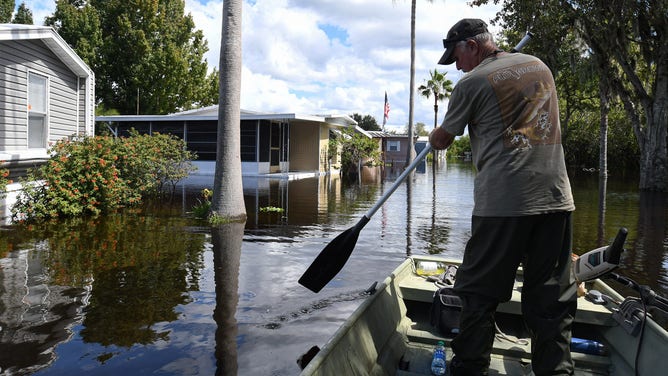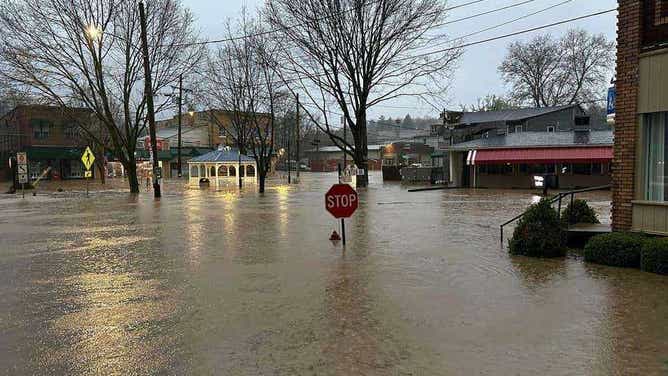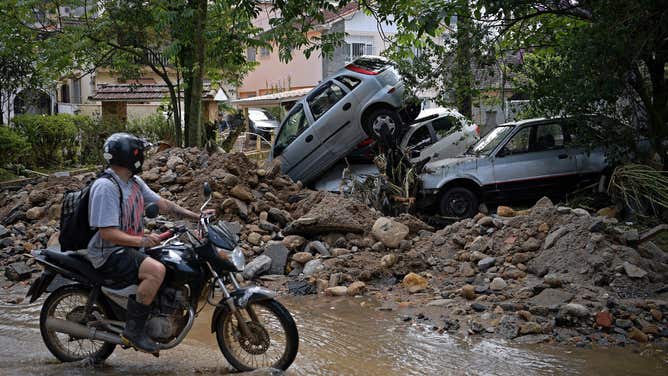Which US counties are most at risk of flooding in 2024?
Flooding has caused more damage in the U.S. than any other severe-weather-related event, according to NOAA.
How to make sure your home is properly insured for all natural disasters
With an extremely active hurricane season forecast, Insurance Information Institute CEO Sean Kevelighan explains that homeowners need to make sure they are covered for all types of disasters, including flood insurance which is not included in standard policies.
You probably aren't thinking about flooding. Most people don't until it happens. However, if you live in one of the counties on this list, maybe you should.
"Flooding caused more damage in the United States than any other severe weather related event, an average of $5-$8.2 billion a year," the Federal Emergency Management Agency stated, quoting NOAA data.
EXTREME WEATHER, FLOODING INFLUENCING WHERE MILLIONS IN US DECIDE TO LIFE, RESEARCH SHOWS

File: A man paddles his boat in a flooded street near his home in St. Cloud, Florida due to rising water levels in the aftermath of Hurricane Ian.
(Paul Hennessy / SOPA Images / LightRocket / Getty Images)
PLAN, PREPARE, PROTECT: HOW TO BEST COVER YOUR PROPERTY AGAINST FLOODS
That annual loss goes up to $179.8-$496.0 billion per year when we consider the economic and tax losses, plus the cost of improving infrastructure to prevent another flood, according to the Senate's Joint Economic Committee. Flooding is responsible for two-thirds of the cost of all natural disasters, according to FloodDefenders.org.
Texas, New Jersey, Florida and Louisiana top flooding risk charts
LawnStarter.com has released its rankings of the most flood-prone counties in the nation. Analysts started with counties that FEMA put at moderate to very high flood risk – 943 in total. They weighted that risk with expected annual loss/economic impact from river and coastal flooding, local demand for flood insurance and the size of the most at risk populations – kids, elderly and folks living in mobile homes.
Texas, New Jersey and Florida dominated the top 10 of the list. Louisiana joined those states to monopolize the top 25, while Pennsylvania, Oregon, South Carolina and Virginia make brief appearances. The Gulf Coast states make up almost half of the top 100 most-at-risk counties.
DO YOU HAVE FLOOD INSURANCE? DO YOU NEED IT?
River flooding caused by hurricanes accounts for much of the risk in Texas and Louisiana. New Jersey's top ranks are largely due to the high cost of living and high economic impact.
Accoarding to FEMA, "flood season" in the U.S. runs from June to November, when parts of the country are most at risk. However, flooding can occur at any time of the year.
Flooding risk maxes out during hurricane season for coastal areas. Spring supercell thunderstorms and heavy summer rains plague the Midwest. Spring ice jams threaten the Northeast and Northwest. Summer monsoons can swamp the West and Southwest.

File: Flooding west of Pittsburgh in the Oakdale area
(EMS - North Huntingdon / FOX Weather)
Much of the country doesn't realize it is at risk
FEMA's maps place about 13 million Americans in a 100-year flood zone. A 2018 study published in Environmental Research Letters suggested that the actual number is closer to 41 million people. As of 2017, only 42% of FEMA's maps reflected accurate flood risk, according to a Department of Homeland Security report.
Urban areas have flooded an average of once every two to three days for the past 25 years, according to University of Maryland research.
"Nearly every day, flooding happens somewhere in the United States or its territories," wrote the National Weather Service Office in Anchorage, Alaska. "Flooding is also one of America's most underrated killers, causing nearly 90 fatalities per year."
‘TURN AROUND DON’T DROWN': FLOOD FATALITIES IN US HIT 5-YEAR HIGH

Cars and earth litter streets after being swept away by flood waters.
(CARL DE SOUZA/AFP via Getty Images / FOX Weather)
In the past 40 years, 99% of U.S. counties have flooded, according to FEMA. At least once, 98% of basements will experience water damage, according to the First Street Foundation. Water damage impacts about 14,000 Americans every day.
Costly floods devastate financial security. The majority of Americans put two-thirds of their wealth in their homes, according to the Federal Reserve Bank of St. Louis. FEMA reports that 40% of small businesses never reopen after a flood disaster. Of those that do, 90% fail within two years.
